Get dinner on the table in just 25 mins with this quick and easy yakisoba recipe. These delicious Japanese stir fried noodles are loaded with fresh veggies and tender pork or chicken, smothered in homemade yakisoba sauce.
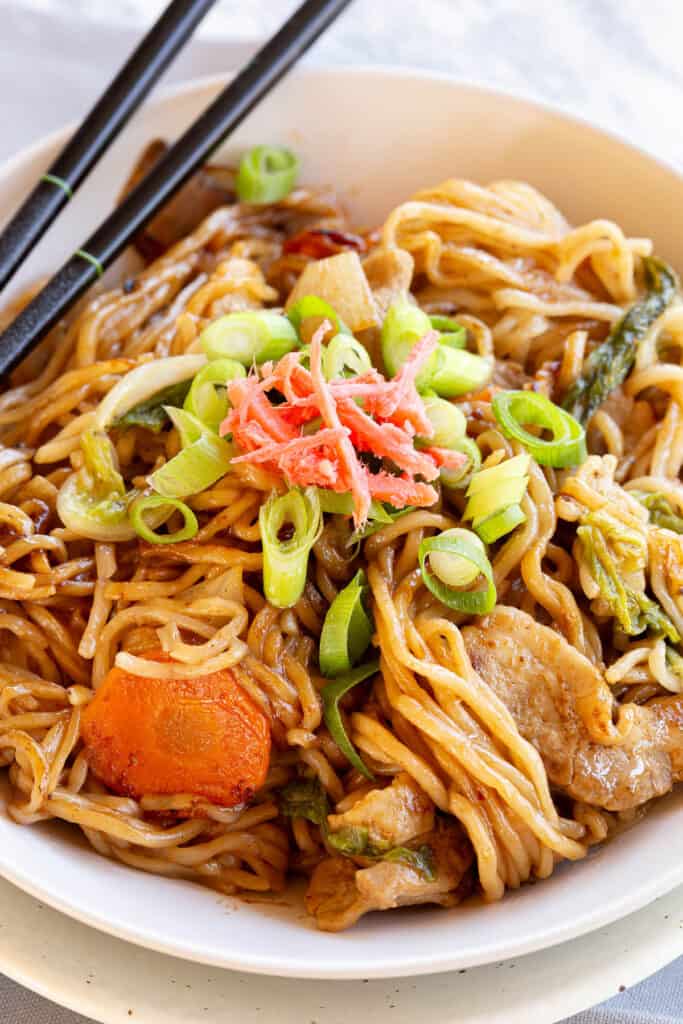
In This Post You’ll Learn
Why We Love This
We love a super quick dinner recipe and yakisoba noodles is one of the BEST.
These flavour-packed Japanese stir fried noodles are also the perfect batch recipe. Fry them up for dinner and you’ll have plenty of leftovers for lunch the next day (or freeze for when you need it most).
Feel free to adapt the recipe to tweak the flavours or or use up leftover veggies from the fridge.
Related: Yaki Udon / Cold Soba Noodle Dipping Sauce
Pork, Chicken or Beef – What Protein Should You Use?
This classic Japanese street food dish is usually cooked with thinly sliced pork belly, but when making yakisoba at home you can use anything you like. The most popular substitutes are chicken, beef or firm tofu. Or you might prefer to use seafood such as fish, squid or prawns / shrimp.
Feel free to experiment and make your favourite style of yakisoba at home. Then leave a comment below and let us know what you like best!
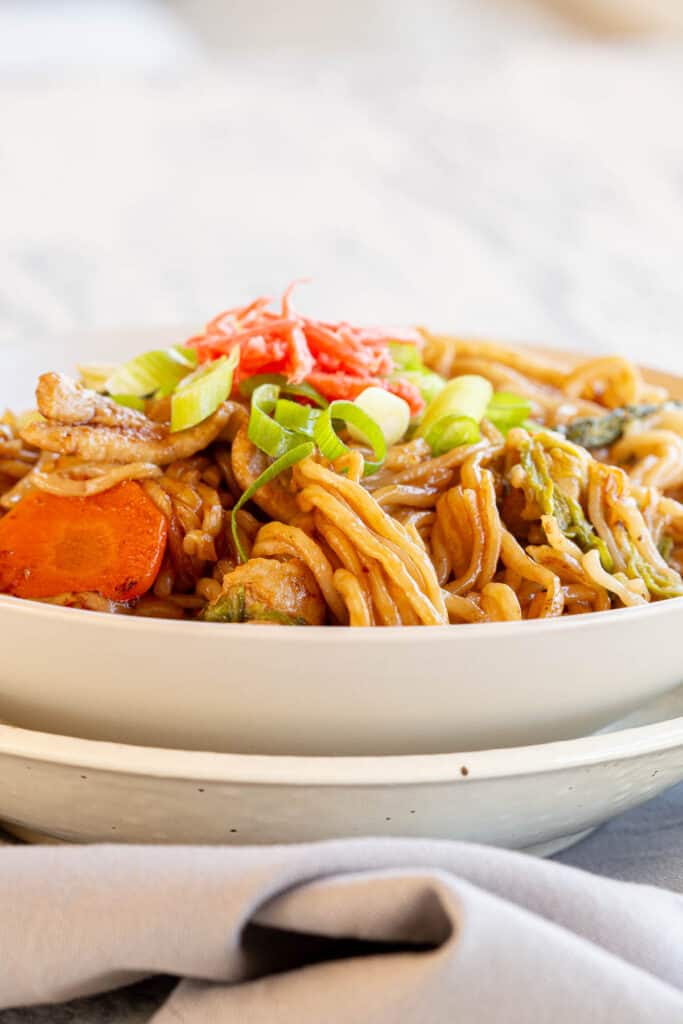
What is Yakisoba?
Yakisoba (焼きそば) is a Japanese stir fried noodle dish quite similar to Chinese chow mein or lo mein. It’s made with long, thin noodles known as mushi chukamen (蒸し中華麺), which are stir fried with veggies and a protein (usually pork).
The key to the classic Japanese flavour in this recipe is a generous slathering of yakisoba sauce. It’s a thick, sweet and savoury sauce, combining the flavours of Worcestershire sauce, ketchup and oyster sauce.
Yakisoba is a popular street food snack in Japan. You’ll often find it sizzling away on piping hot teppans (Japanese hot plates) at street festivals or dished up at baseball stadium, restaurants or izayaka (Japanese bars).
Where We Learnt This
Sarah first learnt how to make yakisoba while living in Japan back in 2010, and it’s been a staple in our household ever since! At home we’ll cook either the traditional pork, onion and carrot combo, or a version of chicken yakisoba with capsicum and broccoli too.
In Japan, we always order a serve of yakisoba alongside a couple of okonomiyaki (‘as you like it’ savoury pancakes). It’s quite popular in Japan to have both together when you go to an okonomiyaki restaurant. There’s even a Hiroshima-style okonomiyaki than can have yakisoba noodles or even udon noodles cooked right into it!
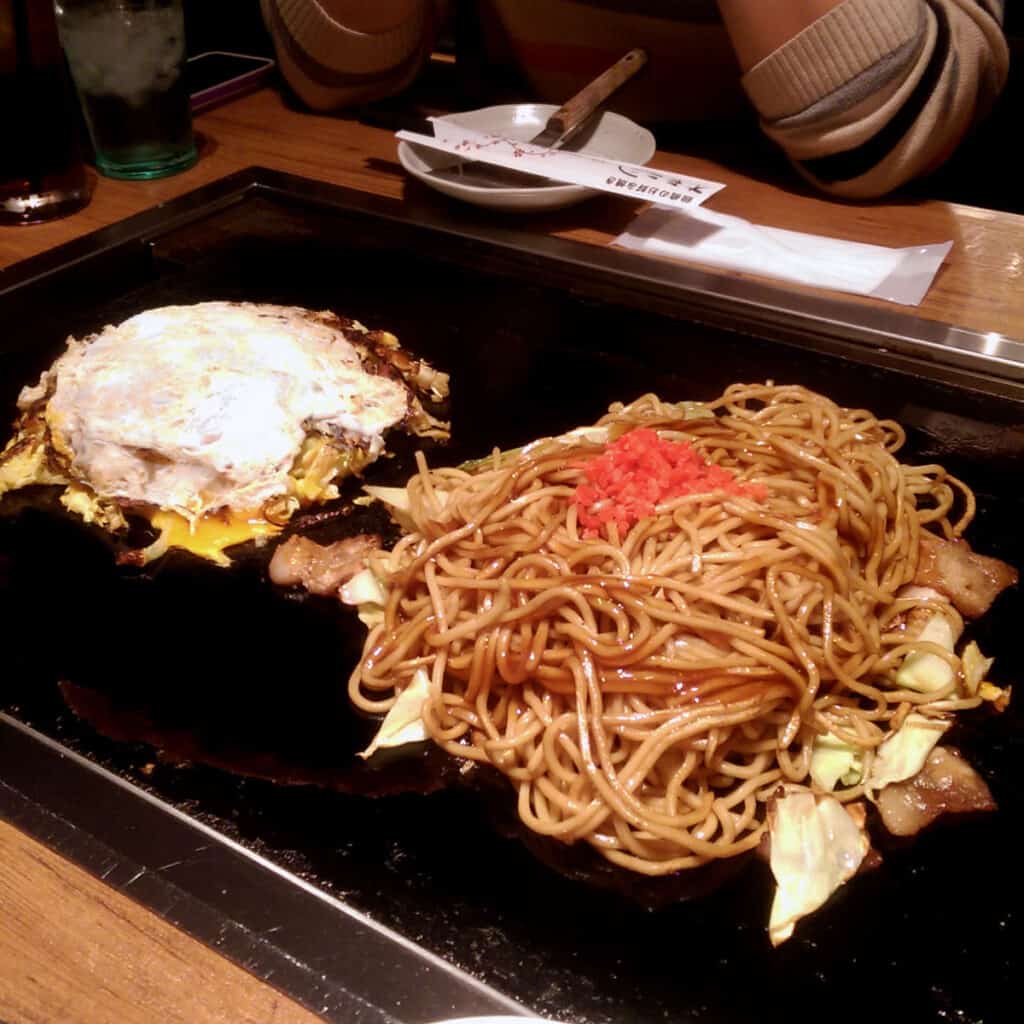
What You’ll Need
- Yakisoba Noodles – Known as mushi chakumen, these are noodles made from wheat flour, water and kansui (a type of lye water) which gives them their golden yellow colour. They’re pre-steamed then packaged, so you can put them straight in the pan without cooking them first. Swap for soba noodles (aka buckwheat noodles), fresh or frozen udon noodles, ramen noodles, Chinese style noodles, or even spaghetti in a real pinch (cook according to package directions and drain before using in this recipe).
- Pork – Thinly sliced pork (such as pork belly) works best because it cooks quickly and absorbs all the delicious flavours in the stir fry. If you’re in Australia, Coles now sells this fresh, otherwise Asian grocery stores often sell super thin hot-pot style pork slices, fresh or frozen, similar to what you find in shabu shabu hot pot.
- Veggies – This dish is most commonly cooked with cabbage, carrot and onion, but you can use any veggies you have on hand. Sub with a store bought coleslaw mix for a super simple tweak, or add your favourite veggies like spring onions / green onions, bok choy or gai lan, spinach, broccoli or broccolini, capsicum / bell pepper, enoki or shiitake mushrooms, renkon (lotus root) or even gobo (burdock root).
- Yakisoba Sauce – This is a sweet and slightly sour sauce which is fairly similar to BBQ sauce. Two of the most popular store bought brands are Otafuku or Bulldog. You can find it at most supermarkets these days, buy yakisoba sauce online or even better – make your own yakisoba sauce at home.
- Sesame Oil – This adds a little extra flavour when cooking the pork. Sub with peanut oil or use vegetable oil only.
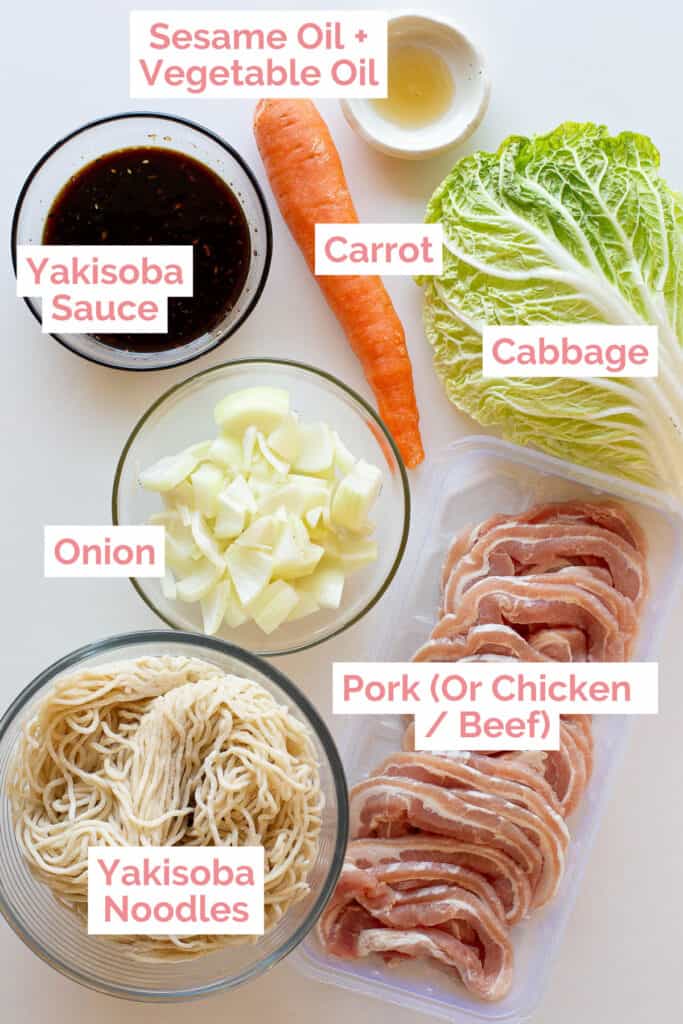
How to Make Yakisoba
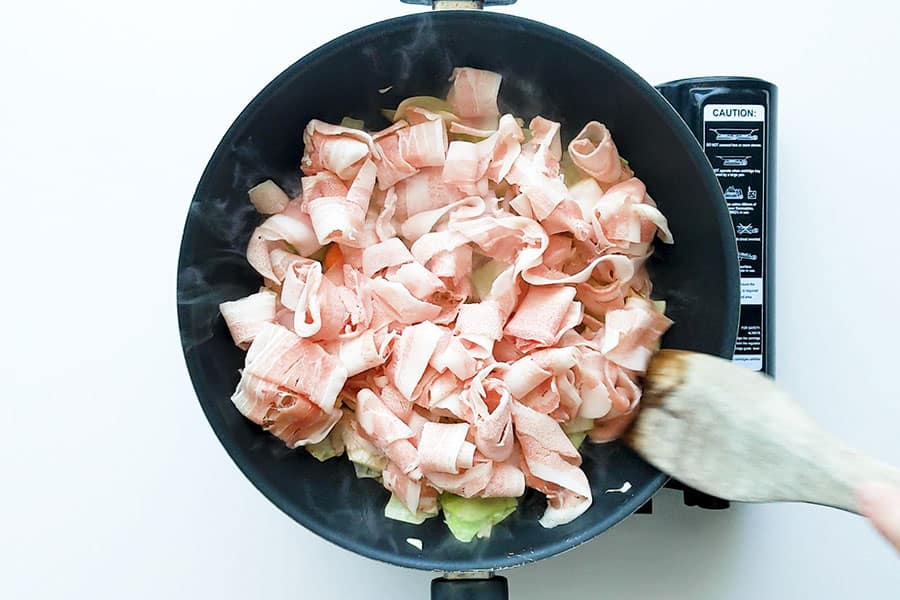
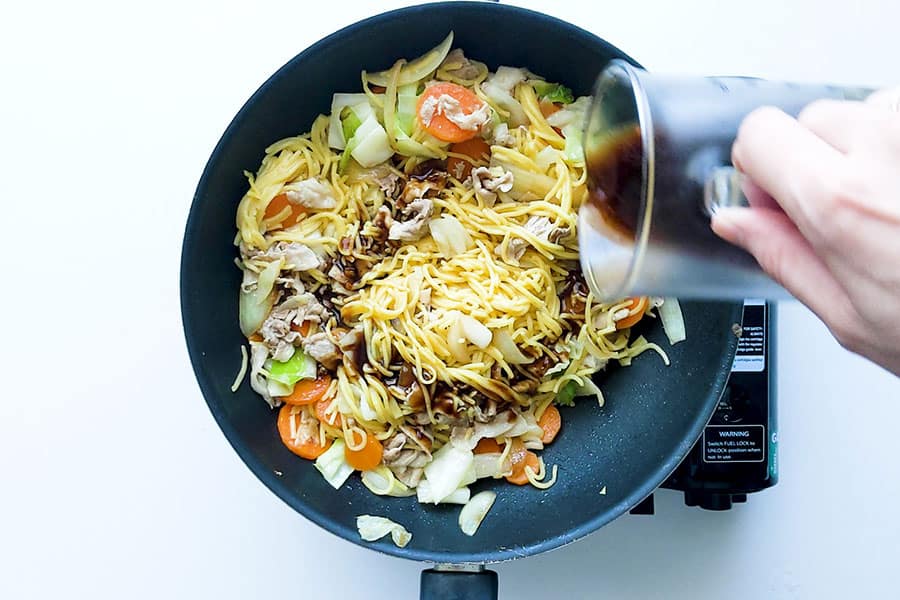
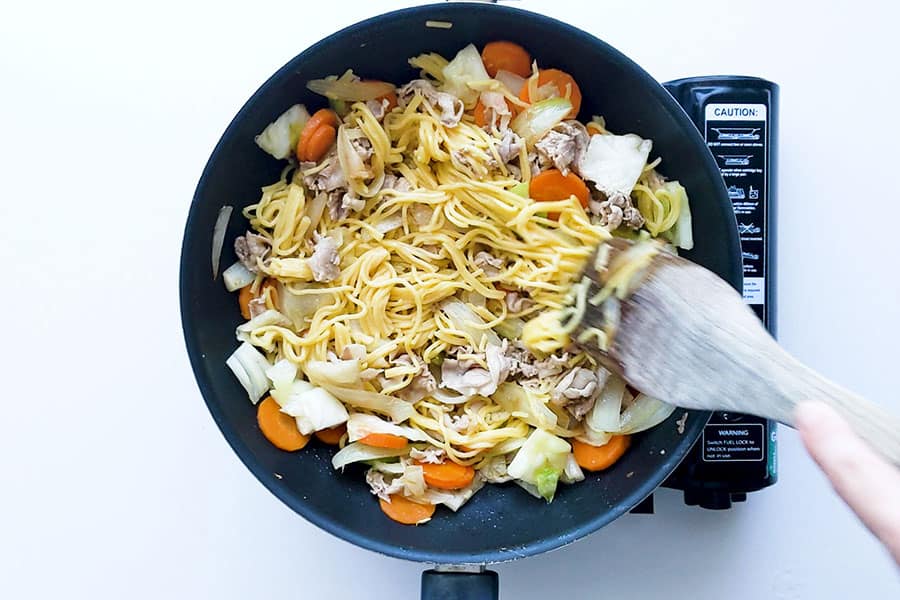
First, gather your ingredients: See recipe card below for measurements.
- Heat the vegetable oil and sesame oil in a wok, frying pan or large skillet over medium-high heat. Add the onions and stir fry for a few minutes until they start to turn transparent, then add the carrots and cabbage and stir fry for a minute or two until they start to soften. Add the thinly sliced pork and continue to stir fry until golden brown.
- Add the yakisoba noodles and stir fry for a few minutes, using your spatula to toss and separate the strands. Once noodles start to become crispy, add half the yakisoba sauce and stir quickly to coat all ingredients evenly.
- Add the remaining yakisoba sauce and stir fry until all ingredients are cooked. Garnish with your favourite Japanese toppings – katsuobushi, aonori, shichimi togarashi, beni shoga etc.
How to Make Yakisoba with Fresh Ramen Noodles
If using fresh ramen noodles, thin yellow Chinese noodles or similar, you should steam the noodles first:
- Bring a steamer to the boil then add in the ramen noodles. Arrange them in a wreath / doughnut shape with a hole in the middle to let extra steam get up and around the pot.
- Place the lid on the steamer, and steam for twice as long (2x) than specified on the packet for boiling time.
- Once steamed, you can either:
Steam Only: Throw the noodles straight into the yakisoba pan and continue as per the recipe. OR
Steam & Boil: Pour the noodles into the steamer water and boil for an extra 3-5 minutes. Then strain, run under cold water then add to your yakisoba pan and continue as per the recipe.
Tip: If you’re not cooking with the noodles straight away, add 1-2 teaspoons of vegetable oil to keep and toss together to prevent them from sticking, then store in an airtight container in the fridge and use within 1-2 days.
How to Make Yakisoba with Spaghetti
Spaghetti for yakisoba is a little unusual, but if you can’t source regular noodles this is a great way to still get your noodle fix.
- Boil 400 g / 14 oz of spaghetti in a large pot with around 4 litres of water.
- Add 1/4 cup of baking soda, and cook for the time specified on the packet.
- Strain and run under cold water in a colander, drain, then add directly into yakisoba as per the recipe.
Wandercook’s Tips
- Leftover Veggies – Sliced red capsicum/bell pepper or zucchini pair nicely with the flavours in yakisoba sauce, as do healthy green veggies like broccoli, snow peas, and bok choy. You could even try adding in baby corn, bean sprouts or water chestnuts for extra texture.
- Leftover Noodles? – Make them into tantanmen ramen the next day!
- Storage – Store leftover yakisoba in an airtight container in the refrigerator for 2-3 days, or in the freezer for around 2-3 months. You can reheat leftovers in the microwave.
FAQs
Make them go even further by using them as a filling in omu-soba (omelette wrapped around yakisoba) or yakisoba pan (yakisoba in a fresh bread roll or hotdog bun).
Yakisoba sauce is a simple combination of 8 ingredients, including soy sauce, Worcestershire sauce, oyster sauce, hoisin sauce, rice vinegar, tomato sauce, sugar and ginger, mixed together in a small bowl. You can easily make a batch of homemade yakisoba sauce in just 5 mins.
Both ramen and yakisoba noodles are wheat noodles made with wheat flour, kansui and water. The main difference is that fresh ramen noodles are packaged raw, while yakisoba noodles (mushi chukamen) are steamed first and then packaged. This means that the way you use them at home is slightly different. See the ‘how to cook yakisoba’ section above for more info.
Variations
- Garnish Ideas – The most popular toppings in Japan are katsuobushi (dried bonito flakes), (aonori seaweed flakes) or beni shoga (red pickled ginger). We love adding toasted sesame seeds or gomashio sesame salt too. You might even like to add a squiggle of kewpie mayo or okonomiyaki sauce on top.
- Make it Vegetarian – Use tofu as your protein for a vegetarian version.
- Serving Ideas – Serve with an entree of takoyaki (octopus balls) and bowl of miso soup.
- Yaki Udon – Try swapping out the noodles for udon noodles for a different texture.
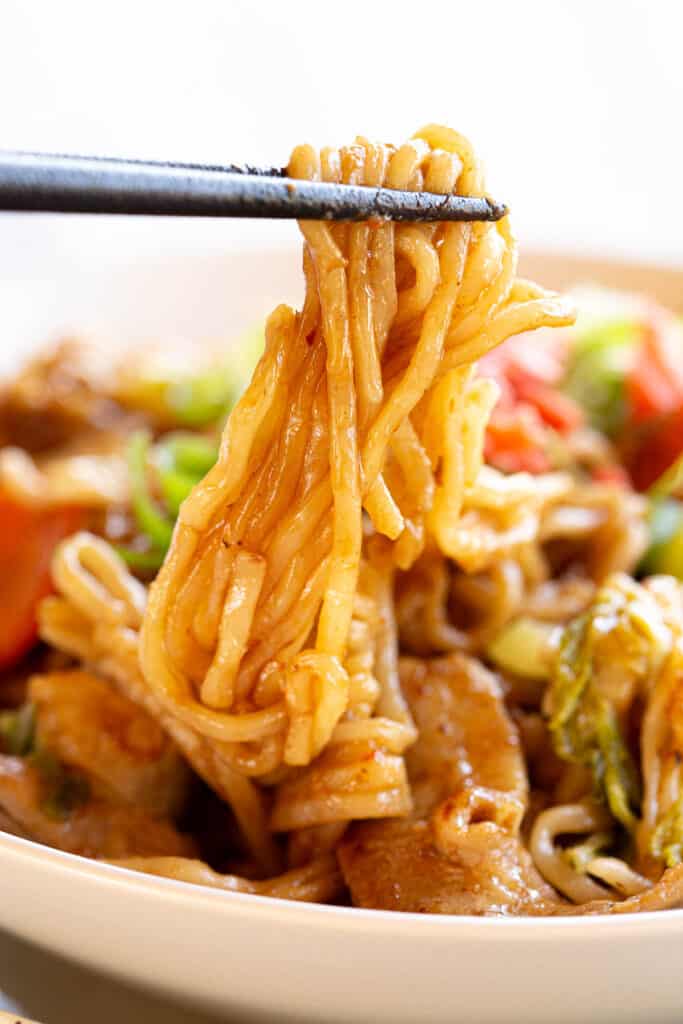
Try these amazing recipes next:
- Japanese Mapo Tofu Udon Noodles – Deliciously spicy pork, tofu and chewy noodles!
- Tantanmen Ramen – Japanese Tan Tan Noodles – Spicy pork and noodles in a light sesame broth.
- One Pot Nikujaga – Beef and Potato Stew – Japanese comfort food.
- Quick 15 Minute Spicy Miso Ramen – Rich and satisfying umami flavour.
- Tsukemen Dipping Ramen – Laura’s favourite way to eat ramen at home!
★ Did you make this recipe? Please leave a comment and a star rating below!
Equipment
Ingredients
- 500 g yakisoba noodles sub with cooked ramen or thin chow mein / Chinese yellow noodles, or udon noodles
- 300 g pork belly thinly sliced, sub pork loin, chicken, beef, seafood or tofu
- 1 onion sliced
- 1 carrot finely sliced
- 100 g cabbage chopped
- 1 tbsp vegetable oil
- 1 tsp sesame oil
- ½ cup yakisoba sauce
Optional garnish:
- 2 tsp white sesame seeds
- seaweed flakes / aonori nori flakes
- beni shoga / red pickled ginger red pickled ginger
- bonito flakes / katsuobushi dried bonito flakes
Instructions
- Heat the vegetable oil and sesame oil in a wok, frying pan or large skillet over medium-high heat.1 tbsp vegetable oil, 1 tsp sesame oil
- Add the onions and stir fry for a few minutes until they start to turn transparent, then add the carrots and cabbage and stir fry for a minute or two until they start to soften. Add the thinly sliced pork and continue to stir fry until golden brown.1 onion, 1 carrot, 100 g cabbage, 300 g pork belly
- Add the yakisoba noodles and stir fry for a few minutes, using your spatula to toss and separate the strands. Once noodles start to become crispy, add half the yakisoba sauce and stir quickly to coat all ingredients evenly.500 g yakisoba noodles, ½ cup yakisoba sauce
- Add the remaining yakisoba sauce and stir fry until all ingredients are cooked.½ cup yakisoba sauce
- Garnish with your favourite Japanese toppings – katsuobushi, aonori, shichimi togarashi, beni shoga etc.2 tsp white sesame seeds, seaweed flakes / aonori, beni shoga / red pickled ginger, bonito flakes / katsuobushi
Video
Recipe Notes
- Yakisoba Noodles – Known as mushi chakumen, these are noodles made from wheat flour, water and kansui (a type of lye water) which gives them their golden yellow colour. They’re pre-steamed then packaged, so you can put them straight in the pan without cooking them first. Swap for soba noodles (aka buckwheat noodles), fresh or frozen udon noodles, ramen noodles, Chinese style noodles, or even spaghetti in a real pinch (cook according to package directions and drain before using in this recipe).
- Pork – Thinly sliced pork (such as pork belly) works best because it cooks quickly and absorbs all the delicious flavours in the stir fry. If you’re in Australia, Coles now sells this fresh, otherwise Asian grocery stores often sell super thin hot-pot style pork slices, fresh or frozen, similar to what you find in shabu shabu hot pot.
- Yakisoba Sauce – This is a sweet and slightly sour sauce which is fairly similar to BBQ sauce. Two of the most popular store bought brands are Otafuku or Bulldog. You can find it at most supermarkets these days, buy yakisoba sauce online or even better – make your own yakisoba sauce at home.
-
Storage – Store leftover yakisoba in an airtight container in the refrigerator for 2-3 days, or in the freezer for around 2-3 months. You can reheat leftovers in the microwave.
Nutrition
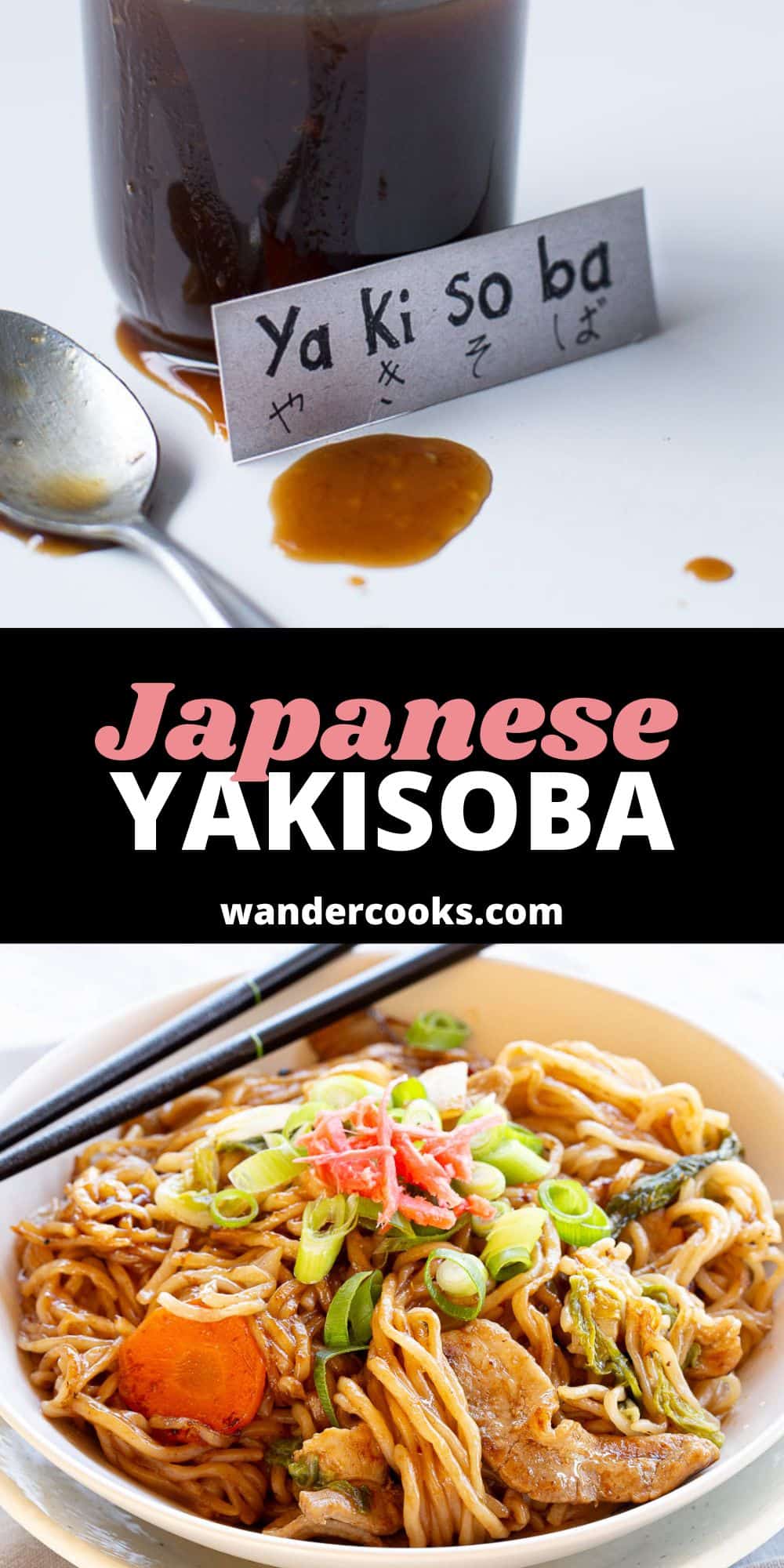

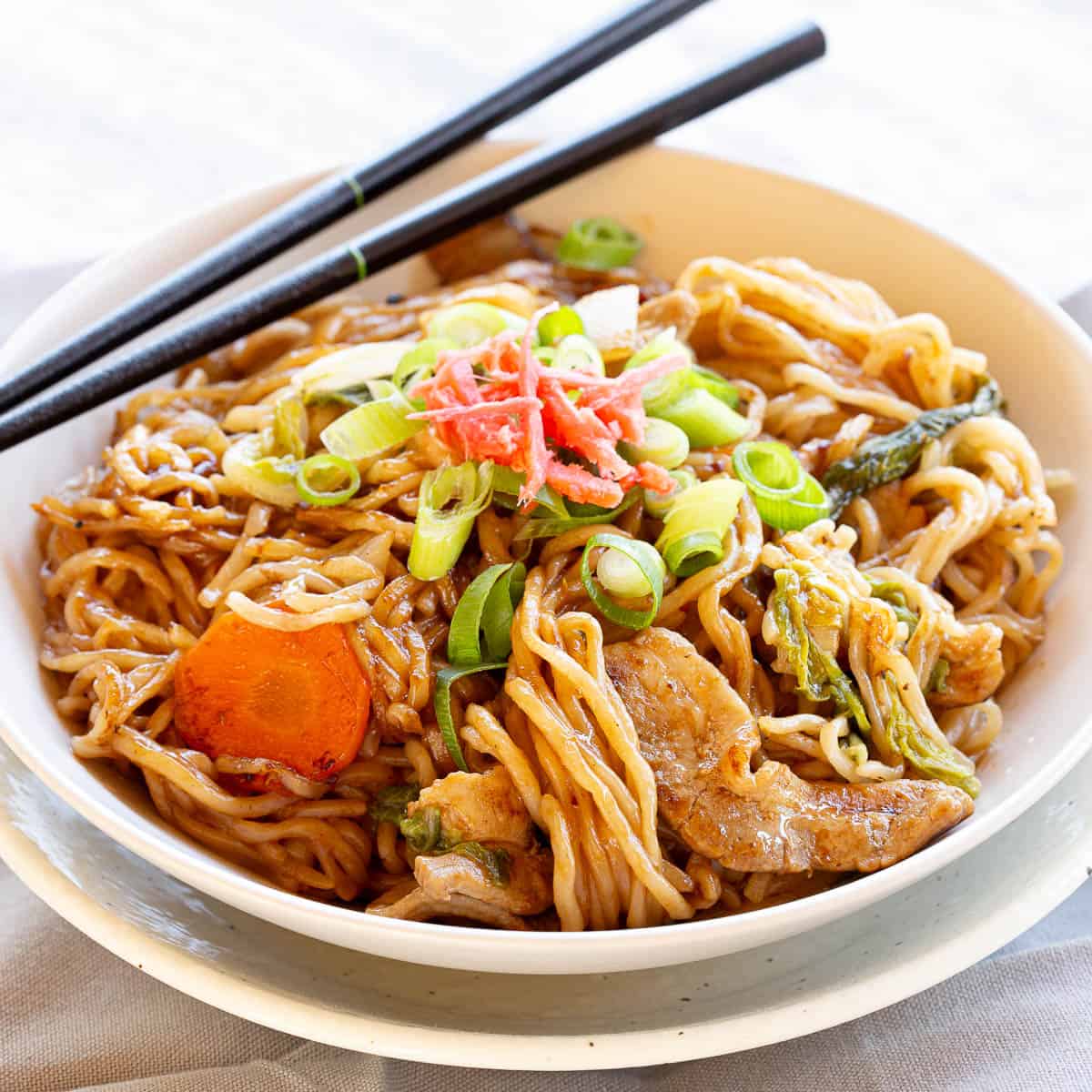


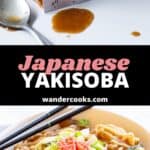
20 Comments
Maria Cimas
04/02/2024 at 12:34 amThis is the second recipe I’ve tried, okonomiyaki being the other one. Unfortunately most of the times I don’t have all ingredients so I love that without asking you put accessible alternatives. In this case I did not have mirin for the sauce or cabbage. Sauce without mirin was still very good and instead of cabbage I put red peppers that I had some in my fridge. I prepared the sauce on a glass jar which proved really useful for the mixing as I just shake it and then store away as i did not use all the sauce. I wish you could have your personal folder where you could save your fav recipes, apart from this, love the general format and how easy you make cooking foreign foods easy.
Wandercooks
05/02/2024 at 12:34 pmAww you’re very welcome! That’s one of our main goals, to help you cook different cuisines no matter where you are in the world. 🙂 For saving your favourite recipes, you can create an account and save them all on our site using the love heart icon in the bottom right corner. 🙂
Leah Cohen
22/07/2021 at 4:57 amDo u have a cookbook with these wonderful japanese recipes I can buy??
Wandercooks
22/07/2021 at 9:59 amHi Leah,
We’re currently putting together a Japanese recipe ebook, which will be available to be downloaded and you can print at home or at a printer. 🙂
Doug Ahmann
15/01/2021 at 10:01 amIs it just me, or do you find that the strength of the Worcestershire sauce sort of cooks off when you add it to the dish? When I taste the sauce straight up, I find it not very appealing. Mainly because of the strong Worcestershire sauce taste. But when cooked in the recipe it’s really good!
Wandercooks
15/01/2021 at 4:11 pmHey Doug, we were just talking about this with someone yesterday in relation to takoyaki and okonomiyaki sauces. They all have a strong Worcestershire base flavour, it’s also worth noting Japanese-style Worcestershire is lighter and sweeter than it’s Western counterpart. You’re right though, once mixed with the noodles or combined with Kewpie mayonnaise in other Japanese dishes, it mellows out so it doesn’t overthrow the other flavours. 🙂 Glad you enjoyed the final result!
Jude Susia
13/11/2020 at 4:21 pmI know you listed the ingredients, but not the measurements. I’d love to make yakisoba for my family because I learned to love it, but the proportions of the sauce ingredients can make or break a sauce. I want to be sure I get it right!
Wandercooks
16/11/2020 at 9:17 amHi Jude, great question. We recommend starting with half a cup of sauce. Pop in 1/4 of a cup first, to coat everything, then the remaining 1/4 cup to get it really saucy. From there have a taste, and if it’s not enough for your liking, add in a couple extra tablespoons at a time to get it just right. 🙂
Eric
30/04/2020 at 2:28 pmYou didn’t mention what step to add the cabbage! I’m guessing after the carrots though, but should note anyway! 🙂
Wandercooks
30/04/2020 at 2:28 pmOooooops! Thanks Eric, yep you’re 100% correct and I’ve fixed the recipe now. Thanks so much for lettings us know! 😀
Ali Randall
30/04/2020 at 2:28 pmHangover or not those noodles look fantastic. I’ve always wanted to know how to make my own bowl and now I know. And I don’t have to go to Japan either. Bonus
Wandercooks
30/04/2020 at 2:28 pmThat’s what we love about cooking – you can travel anywhere from your very own kitchen! Enjoy your Japanese adventures Ali! 🙂
Sara | Belly Rumbles
30/04/2020 at 2:28 pmNoodles and dumplings are my go to hangover easer, not quite a cure, but do make you feel like you can function again! Your Yakisoba noodles look delicious, will have to try this for a mid week meal for the family.
Wandercooks
30/04/2020 at 2:28 pmIs there anything noodles can’t do? Haha thanks Sara, hope you enjoy!
Lisa | Garlic & Zest
30/04/2020 at 2:28 pmYes! Yes! Yes! I want this right now! Beautiful photos, but I mean, I just want to reach into the screen!
Wandercooks
30/04/2020 at 2:28 pmOh if only Lisa. Can you imagine what life would be like if we could do that??? 😀
Luci {Luci's Morsels}
30/04/2020 at 2:28 pmI love eating yakisoba noodles when my husband and I go out, but I’ve never made them at home before! Thanks for this easy to follow recipe and inspiring me to try it myself!
Luci’s Morsels | fashion. food. frivolity.
Wandercooks
30/04/2020 at 2:28 pmGlad we could help Luci! They’re so delicious aren’t they? Literally can’t stop until we’ve picked the plate clean with our chopsticks haha. 😛
Platter Talk
30/04/2020 at 2:28 pmMmmm. This sounds like a really good Asian noodle recipe. I think that it would be really good with stir fry shrimp!
Wandercooks
30/04/2020 at 2:28 pmOooh yes, definitely! I think next time we’ll do it with pork and shrimp/prawn! 🙂